The Detroit Red Wings have had a lot of incredible goaltenders throughout franchise history, and some stood out more than others in terms of their play, but also how their setups looked out on the ice. The Hockey Writers’ Red Wings team joined forces to highlight their favorite goaltenders, as well as what made them so special compared to the rest.
Jimmy Howard — Delaney Rimer
One of the most successful goalies in Red Wings history, Jimmy Howard spent his entire 14-year NHL career behind the winged wheel, and donned some iconic gear in that time span. His most iconic setup was his iceberg-style Vaughns that he wore from roughly 2008 to 2014. He went through a number of different brands (primarily Vaughn), patterns, and styles throughout his lengthy career, but the icebergs are what immediately come to mind for me when I think of him.
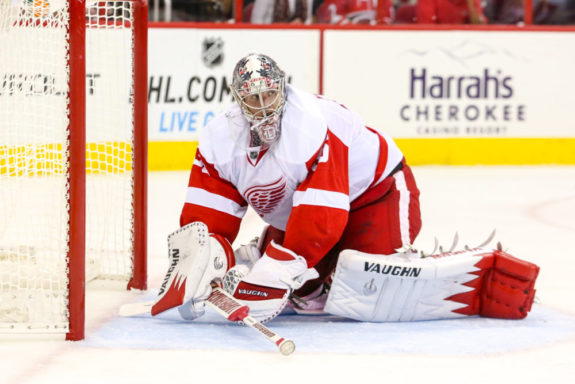
Howard is the third winningest goaltender in Red Wings history, with 246 wins and 543 games played. His career began when the Red Wings selected him 64th overall in the 2003 NHL Draft. He then joined the team on the ice for the first time in the 2005-06 season. Howard leads Red Wings goaltenders in both shots against, with 15,313, and saves, with 13,970. That ultimately left him with a .912 save percentage for his 14-year career.
My personal favorite helmet that Howard wore was his “Tribute to the Joe” helmet from the final season in Joe Louis Arena. This helmet, painted by Bishop Designs, featured Steve Yzerman hoisting the Stanley Cup on one side as well as the four years he did so (1997, 1998, 2007, and 2008) in stars on the chin. The other side paid homage to Mr. Hockey himself, with a portrait and his number nine and Joe Louis Arena behind him. Truly the coolest part of this helmet was the polaroid style images of historic moments in the Joe to honor the incredible moments that the arena held.
The reign of Howard’s iceberg pads came to an end with the start of the 2014-15 season, when he opted to switch to a primarily red Vaughn setup; consisting of Vaughn V6 2200 leg pads, catcher, and blocker while still rocking his usual Warrior Swagger stick. He donned the red setup until the end of his remarkable career in the 2019-20 season. Howard provided the Red Wings with a reliable backboard for season upon season until finally choosing to retire just as the league started to experience changes related to the COVID-19 pandemic.
Mike Vernon — Rob Klein
After 10 seasons in Calgary, including a Stanley Cup Championship in 1989, Mike Vernon was traded to Detroit on June 29, 1994, for defenseman Steve Chiasson after the Flames decided to go with Trevor Kidd. The Red Wings went through quite the goalie carousel during the 90s in search of their first Stanley Cup since 1955. Some of the names that played in net for Detroit between 1990 to 1994 included Tim Cheveldae, Bob Essensa, Vincent Riendeau and Chris Osgood (22 years old), who was deemed too young at the time for a team that management felt was on the cusp of a championship.
Vernon did not have a stellar season in 1997, going 13-11-8 in 33 games played. Osgood received the majority of the games that season, and posted a 23-13-9 record in 47 games. One of Vernon’s signature victories that season came on March 26, 1997, in a 6-5 overtime win that featured the famous brawl with Colorado in retaliation for a hit on Red Wings forward Kris Draper by Claude Lemieux during Game 6 of the Western Conference Final. As part of a full-on ice melee where Darren McCarty would get his retaliation on Lemiuex, Vernon squared off with Avalanche goalie Patrick Roy near center ice as a part of 18 fighting majors that were called during that incident.
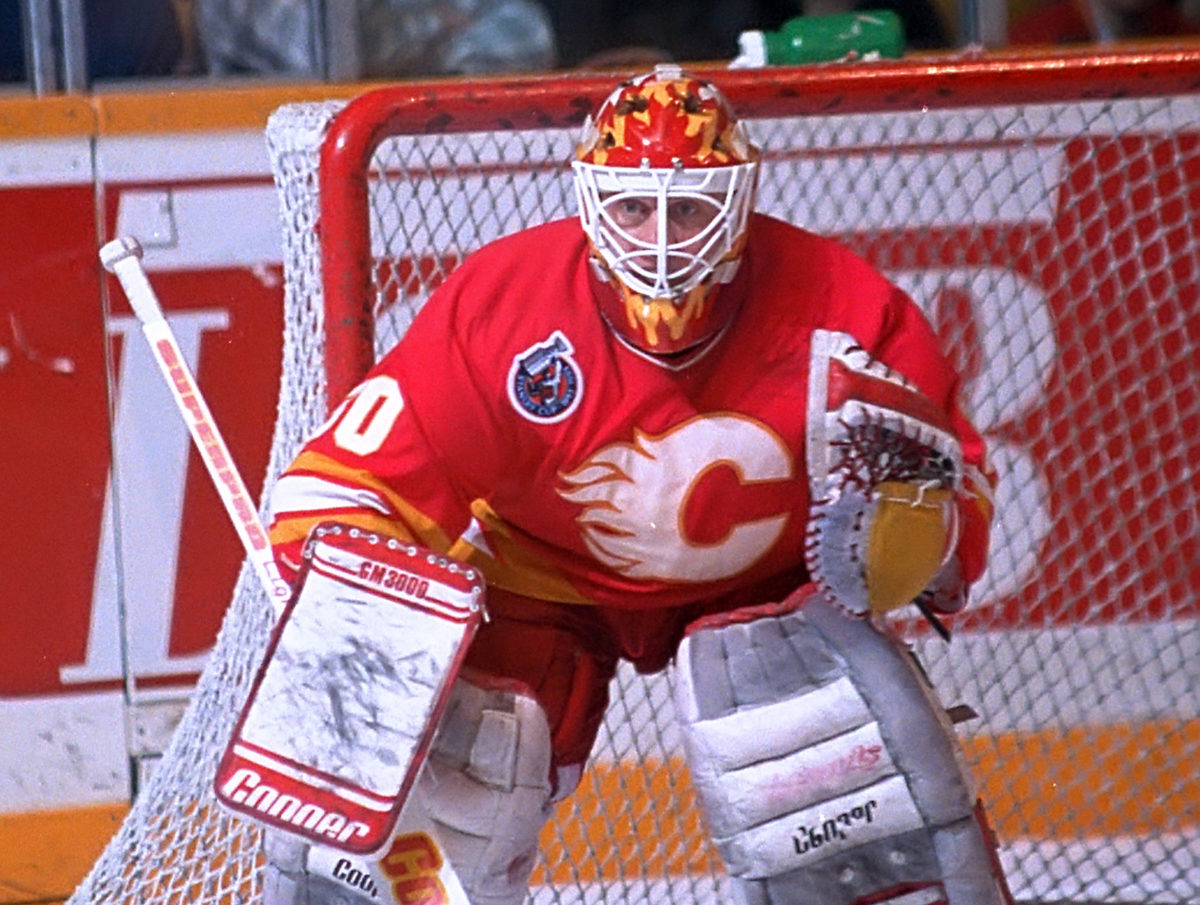
Regarding his setup in his remarkable 1997 playoff run, Vernon donned a blocker and glove both made by Vaughn that were primarily red with white accents in addition to some stunning leg pads. These pads, in particular, were McMillan Phantom IIs that had a design featuring red and white stripes as well as buckle-like elements printed onto the pads on top of diagonal stripes. Having a setup so unique that it is hard to put into words was a constant theme throughout Vernon’s career, but even his plainer setups had stunning detail, such as the coloring on the glove seen in his Calgary setup above.
Vernon was tabbed the starting goalie for the 1997 playoffs, and played his best hockey, posting a 1.76 goals-against average while winning more games during the playoffs than he did during the regular season. His 16-4 record, in fact, helped Detroit win its first Stanley Cup championship in 42 years. In three seasons with the Wings, Vernon had a 53-24-14 regular-season record with a 2.40 goals-against average before getting traded to San Jose for two draft picks.
Chris Osgood – Delaney Rimer
You most likely know him for his Cooper SK2000 helmet and HM30 cage combination, and this Red Wings goaltender garnered the second-most wins in franchise history. Yes, THAT helmet — the one that looked like any standard bucket with a white cage slapped on it. Chris Osgood spent 14 seasons as a Red Wing, with a short gap from 2001 to 2004, where he was with the New York Islanders for almost two seasons and then the St. Louis Blues for just over one season before returning to Detroit.
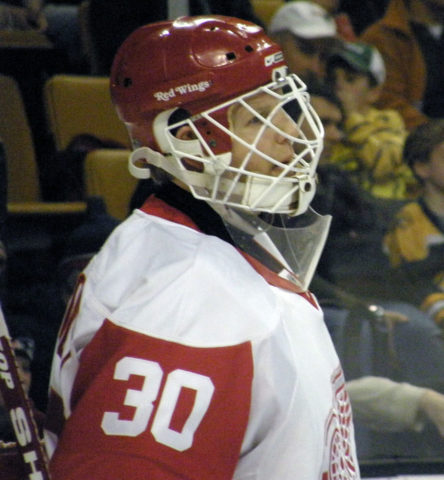
Throughout his career with the Red Wings, Osgood maintained a .905 save percentage through 565 games played, and is the only goalie in NHL history to win more than 400 games (317 of which were with the Red Wings) and lose fewer than 250. On top of all of these already impressive statistics, Osgood raised the Stanley Cup not once, not twice, but three times in 1997, 1998, and 2008.
Osgood’s helmet was never painted because he wanted to blend in, but it ended up making him stand out anyways. This helmet, in particular, the Cooper SK2000, became known as “The Helmet” due to how recognizable and bizarre it was to see out on the ice.
“The Helmet” was not nearly as comfortable or safe as the run-of-the-mill helmets at the time, as it absorbed much more of the shot impact than others would.
“I like the fact I was the last guy to use it,” he says, “That’s part of the reason that I kept using it.”
-Chris Osgood (from ‘Osgood retires, and takes The Helmet with him,’ The Toronto Star, 7/30/11)
On top of the discomfort, these helmets were few and far between and were essentially extinct, yet Osgood simply did not want to switch even if he tried. He ended up finishing his career out with a couple of HM30 cages from the then-team masseuse’s garage in Russia — an odd place to find a replacement part for an infamously odd helmet.
Dominik Hasek – Rob Klein
Dominik Hasek played 16 seasons and 735 games, finishing with 389 wins while playing for four teams (Chicago Blackhawks, Buffalo Sabres, Detroit Red Wings, Ottawa Senators). His 2.20 goals-against average is the best for retired goalies in the modern era, which is after the league expanded from the Original Six format in 1967. He won the Vezina Trophy, which is awarded to the league’s top goalie, six times in eight seasons, and the Hart Trophy for league MVP in 1997 and 1998. He is the only goalie to win the award more than once, and he finished in the top three voting for the Hart Trophy three other times.
Related: Red Wings’ 10 Hall of Famers on 2002 Stanley Cup Team
The 2002 Red Wings team that Hasek was a part of in Detroit was vastly different than any other team he had been on before, such as the Buffalo Sabres, who traded him to the Red Wings in 2001. That team was loaded with future Hall of Famers, including forwards Brendan Shanahan, Sergei Fedorov, Brett Hull, Luc Robitaille, Steve Yzerman, and defensemen Igor Larionov, Nick Lidstrom and Chris Chelios. That season, Hasek went 41-15-8 with a 2.17 GAA and a .915 SV%, winning his first of two Stanley Cups as a member of the Red Wings.
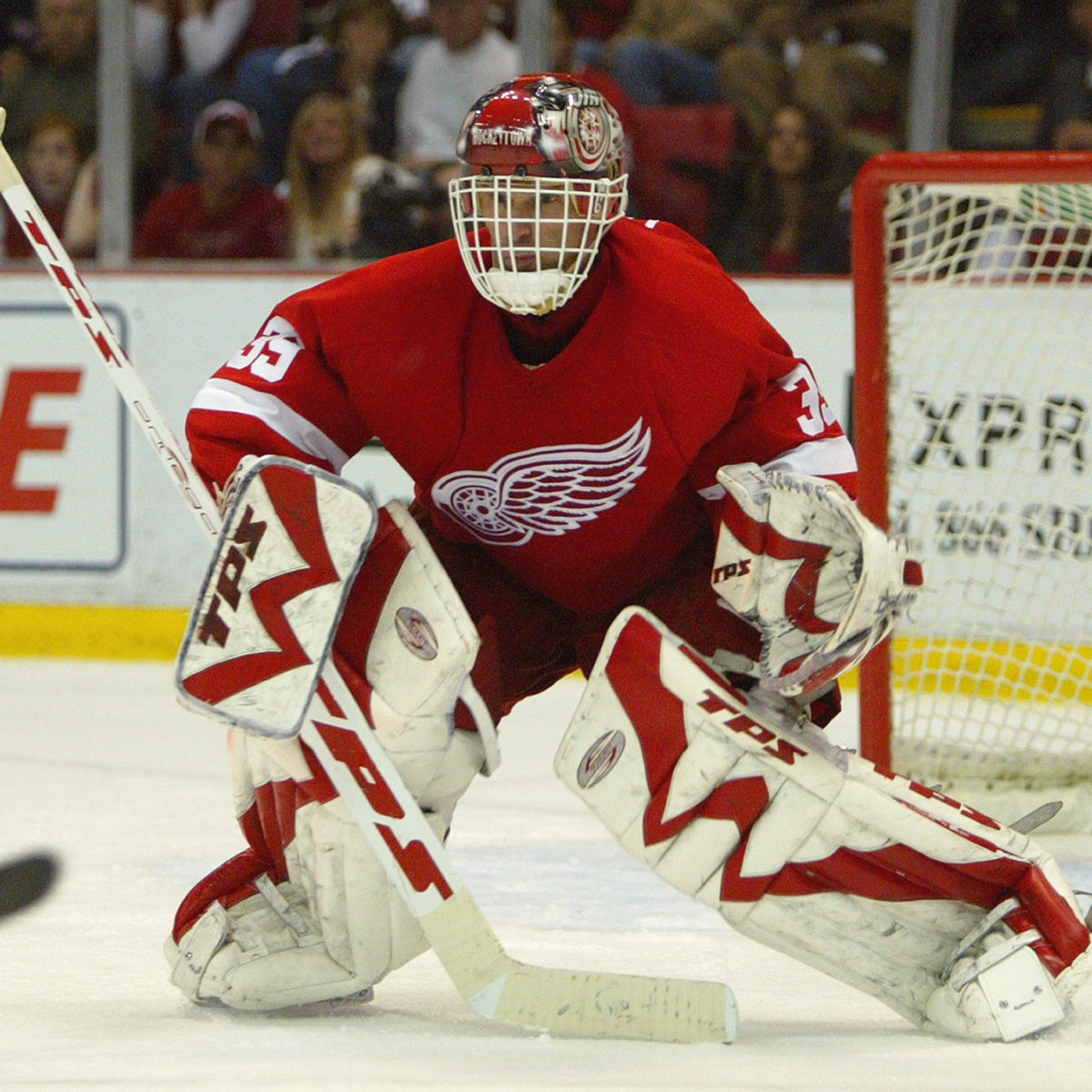
Hasek donned some unique pads, such as the “zig-zag” patterned ones pictured above, in his time with the Red Wings and throughout his entire career. A majority, if not all, of his setups used as a Red Wing were by TPS and stood out on the ice by bringing new designs and patterns to the spotlight as goalie gear customization became more advanced. His gear was not the only standout feature of Hasek’s game, but it certainly made him more memorable for goalie enthusiasts across the league.
For all of his accomplishments in the game, Hasek is just as known for his unique style in net. He wasn’t the classic butterfly or standup goalie by any means. “He tends goal the way Kramer enters Seinfeld’s apartment, a package of flailing arms and wild gesticulations that somehow has a perfect logic.” That’s how Sports Illustrated’s Michael Farber described him. In an era when goalies gravitated toward the “butterfly” style — a structured and systematic approach to their position — Hasek got superior results by appearing to be largely improvisational, to the point of having no style at all. Fortunately for the Red Wings, that style helped bring two more Stanley Cup championships back to Hockeytown.
Manny Legace — Logan Horn
Manny Legace was drafted 188th overall in the 1993 Draft by the Hartford Whalers after three good OHL seasons. He never played an NHL game for Hartford, and was traded to the Los Angeles Kings a few seasons later, where he played 17 games. As a free agent in the 1999 offseason, Legace signed a contract with the Red Wings before getting waived and picked up by the Vancouver Canucks. His tenure in Vancouver was incredibly short lived, as they put him back on the waiver wire just a few weeks later, where the Red Wings re-acquired him.
This is where Legace’s career began to take off, as he earned the full-time backup position behind Osgood to start the 2000-01 season. However, Osgood had a very slow start, which led to Legace playing 39 games over the course of the season, where he had an excellent 24-5-5 record. Legace played backup to even more excellent goaltenders shortly after, as he played behind Hasek in 2001-02 and Curtis Joseph in 2002-03 before Hasek made a surprise NHL comeback.
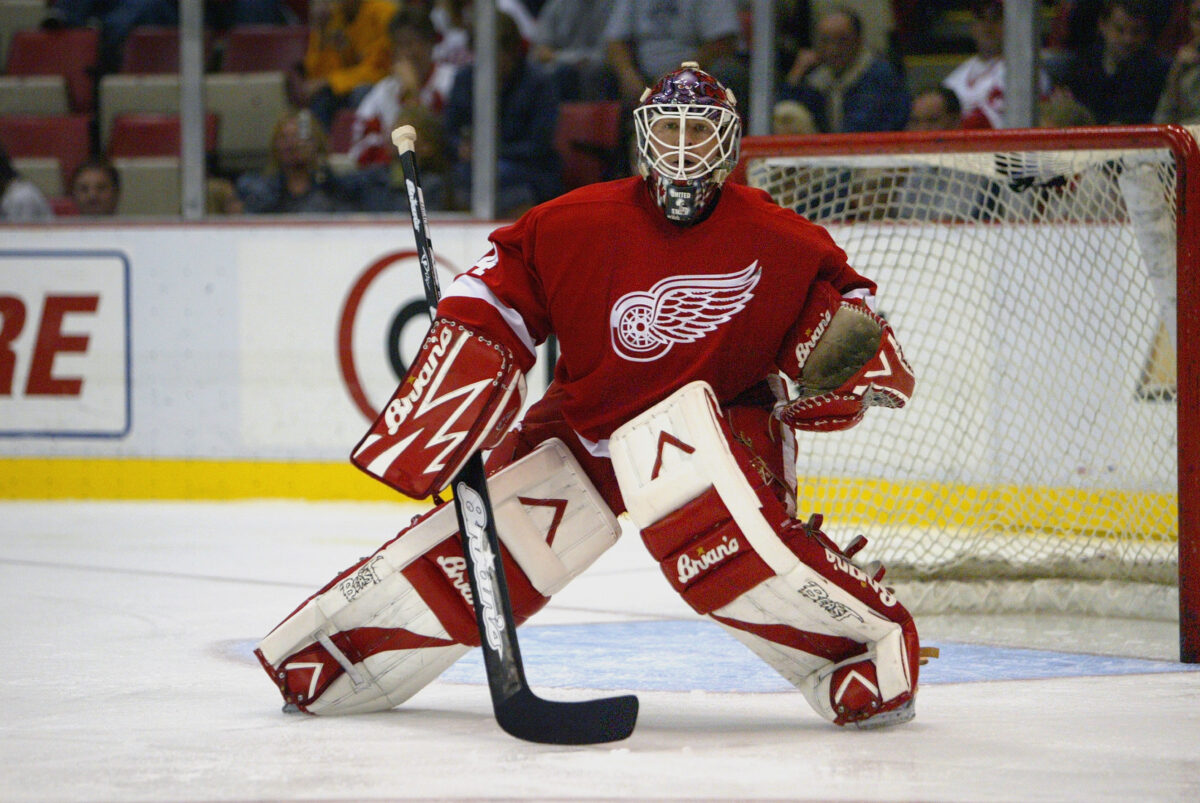
Legace had earned the trust of his teammates and coaching staff as the backup, so Joseph (who was making eight million dollars per year) began the season in the AHL while Legace backed up Hasek. One of Legace’s few seasons as a starting goaltender in the NHL was the 2005-06 season that followed the lockout. He had to fight with a recently returned Osgood for starts, but he finished the season as the starter and earned 37 wins in only 51 games.
Legace’s equipment was always top-notch, and is an excellent distillation of 90s and 00s goaltending equipment. The exact pads I have in mind are his all-white Brians pads that have aged remarkably well, and look amazing in action. The Red Wings jersey and equipment have always thrived with their two-tone colour palette, and Legace’s gear always served to enhance the aesthetic while looking sick in the process. Red and white gloves/blockers and all-white pads and helmets are a huge part of my memory of some of those incredibly Wings teams of the early 2000s.
Petr Mrazek – Devin Little
From the moment Petr Mrazek showed up to the Grand Rapids Griffins with a mask that featured an image of Peter Griffin from Family Guy on it (get it?), I knew I was going to like him. That was the 2012-13 season, and he followed up a strong regular season in the American Hockey League with an even better postseason, earning all 15 wins required to secure the franchise’s first Calder Cup championship. As a Grand Rapids native, born and raised, that playoff run earned him a place in my heart that he still holds to this day.
By the 2014-15 season, Mrazek had arrived in Detroit, providing the Red Wings with a solid one-two punch in goal with the up and coming Mrazek and the steady veteran, Jimmy Howard. Mrazek stood out mostly due to his willingness to play the puck and his overall aggressive style in the crease, but, like his counterpart, he also stood out due to his innate sense of fashion.
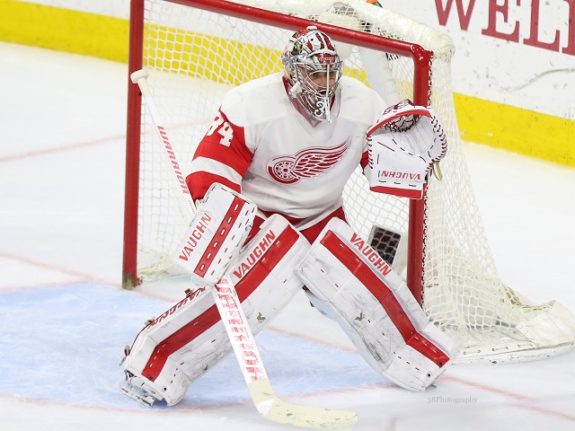
Always sporting a setup made by Vaughn, some of my favorite setups of his include the leg pads that featured half of the winged wheel on one leg and the other half on the other leg, and the set of Vaughn Pulses that he wore during the Griffins’ Calder Cup run (I own a bobblehead of him wearing these pads.) While Mrazek slowly fell out of favor in Detroit, culminating in the trade that sent him to the Philadelphia Flyers in 2018, he was nothing if not super stylish during his tenure in Detroit.
Though he never became the Red Wings’ goaltender of the future that many assumed he would be, Mrazek was a treat to watch in his first few years within the Red Wings’ organization. Because of that, as well as his lasting legacy as the first goalie to lead the Griffins to Calder Cup glory, I still cheer him on to this day.